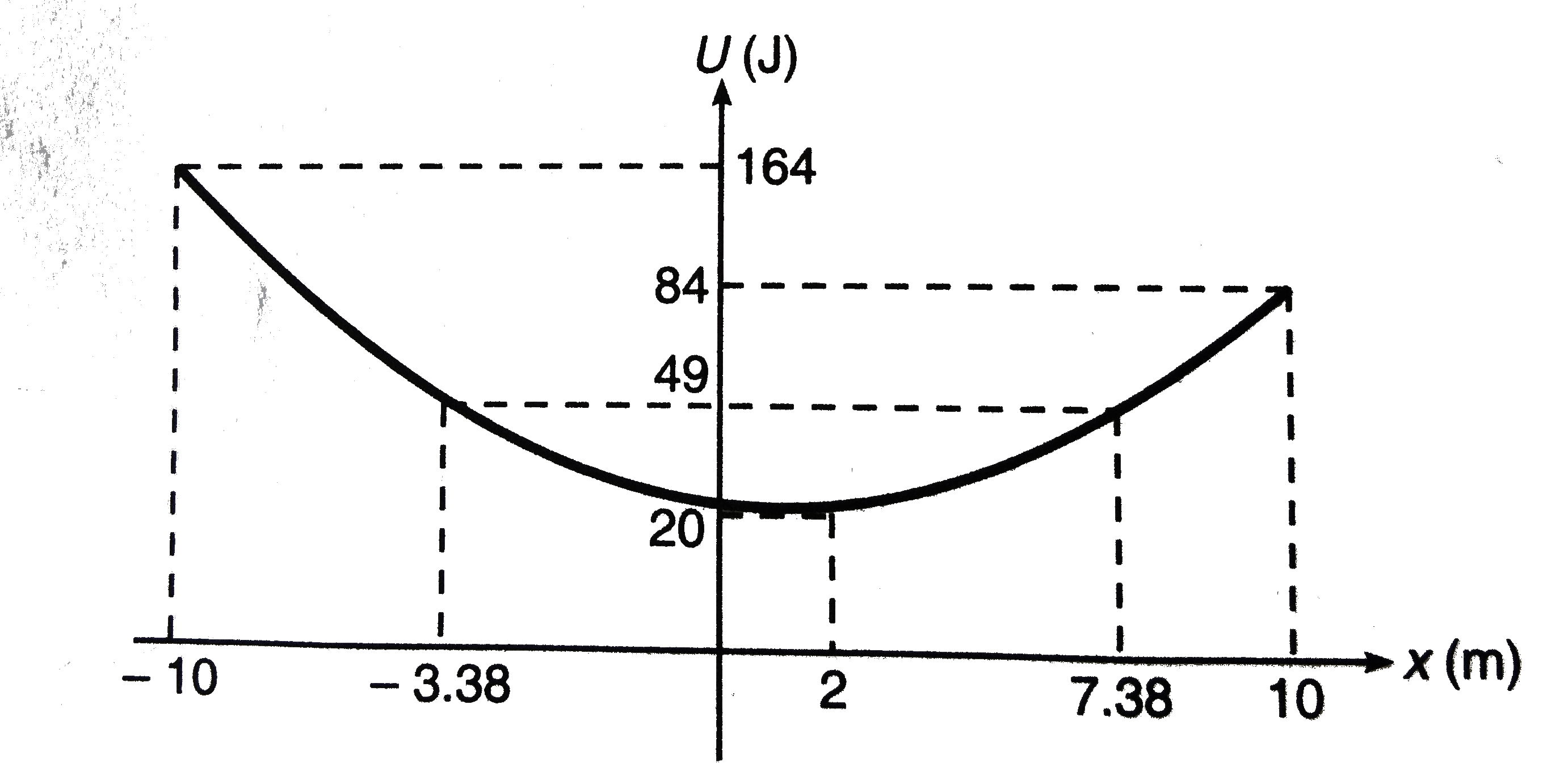A single conservative force F(x) acts on a on a (1.0kg ) particle that moves along the x-axis. The potential energy U(x) is given by:
U(x)=20+(x−2)2
where, x is meters. At x=5.0m the particle has a kinetic energy of 20J
(a) What is the mechanical energy of the system?
(b) Make a plot of U(x) as a function of x for −10m≤x≤10m, and on the same graph draw the line that represents the mechanical energy of the system. Use part (b) to determine.
(c) The least value of x and
(d) the greatest value of x between which the particle can move.
(e) The maximum kinetic energy of the particle and
(f) the value of x at which it occurs.
(g) Datermine the equation for F(x) as a function of x.
(h) For what (finite ) value of x does F(x)=0?.
The correct Answer is:B, C
(a) Potential energy at x=5.0m is
U=20+(5−2)2=29J
∴ Mechanical energy
E=K+U=20+29=49J
 .
.
(b) At x=10m U=84J at x=−10m, U=164J
and at x=2m, U=minimum=20J
(c) and (d) Particle will move between the points where its kinetic energy becomes zero or its potential energy is equal to its mechanical energy.
Thus, 49=20+(x−2)2
or (x−2)2=29
or x−2=±√29=±5.38m
∴x=7.38m and −3.38m
or the particle will move between x=−3.38m and x=7.38m
(e) and (f) Maximum kinetic energy is at x=2m, where the potential energy is minimum and this maximum kinetic energy is,
Kmax=E−Umin=49−20
=29J
(g) F=−dUdx=−2(x−2)=2(2−x)
(h) F(x)=0, at x=2.0m
where potential energy is minimum (the position of stable equilibrium).
Topper's Solved these Questions
- WORK, ENERGY & POWERBOOK - DC PANDEY ENGLISHCHAPTER - WORK, ENERGY & POWEREXERCISE - Exercise 9.1
10 Videos
- WORK, ENERGY & POWERBOOK - DC PANDEY ENGLISHCHAPTER - WORK, ENERGY & POWEREXERCISE - Exercise 9.2
9 Videos
- WORK, ENERGY & POWERBOOK - DC PANDEY ENGLISHCHAPTER - WORK, ENERGY & POWEREXERCISE - TYPE2
1 Videos
- WAVE MOTIONBOOK - DC PANDEY ENGLISHCHAPTER - WAVE MOTIONEXERCISE - Integer Type Question
11 Videos
- WORK, ENERGY AND POWERBOOK - DC PANDEY ENGLISHCHAPTER - WORK, ENERGY AND POWEREXERCISE - MEDICAL ENTRACES GALLERY
33 Videos
Similar Questions
A single conservative force F(x) acts on a 1.0−kg particle that moves along the x-axis. The potential energy U(x) is given by U(x)=20+(x−2)2 where x is in meters. At x=5.0m, the particle has a kinetic energy of 20J.
What is the mechanical energy of a system?
View SolutionA single conservative fore Fx acts on a 2kg particle that moves along the x-axis. The potential energy is given by.
U=(x−4)2−16
Here, x is in metre and U in joule. At x=6.0m kinetic energy of particle is 8J find .
(a) total mechanical energy
(b) maximum kinetic energy
(c) values of x between which particle moves
(d) the equation of Fx as a funcation is zero
(e) the value of x at which Fx is zero .
View SolutionA conservative force acts on a 4 kg particle in x direction. The potential energy U(x) is given by U(X)=40+(x–6)2, where x is in metre. If it is given that at x = 8 m, KE is 30 J then find the maximum KE of the particle.
View SolutionA particle of mass 4 kg moves along x axis, potential energy ( U ) varies with respect to x as U=20+(x−4)2 , maximum speed of paritcle is at
View SolutionA particle moves along the x-axis from x=0 to x=5m under the influence of a given by F=7−2x+3x2. The work done by the applied force to the particle is.
View SolutionThe potential energy of a body is given by U=A−Bx2 (where x is the displacement). The magnitude of force acting on the partical is
View Solutionathe potential energy of a particle of mass 2kg moving along the x-axis is given by U(x)=4x2−2x3( where U is in joules and x is in meters). The kinetic energy of the particle is maximum at
View SolutionA particle moves along the X-axis x=0 to x=5 m under the influence of a force given by F=10−2x+3x2. Work done in the process is
View SolutionLet gravitational potential energy U is given by U=A√xB+x2, where x is distance. The dimensional formula of A/B is
View SolutionThe potential energy of a force filed →F is given by U(x,y)=sin(x+y). The force acting on the particle of mass m at (0,π4) is
View Solution
